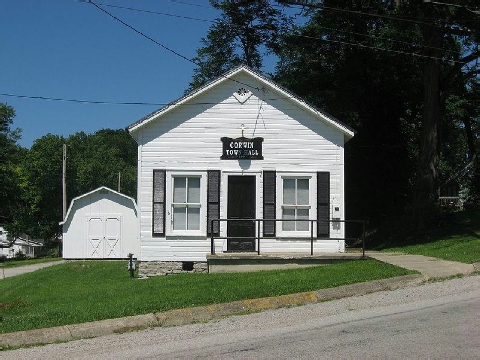Corwin Council House and Jail Historic Landmark Application

Corwin, Ohio is located directly East of Waynesville across the Little Miami River. It was founded in 1844 by John Johnson and Joel W. Johnson in anticipation of the construction of the The Little Miami Railroad. Although the name “Johnstown” was considered, the little hamlet was named “Corwin” after Thomas Corwin of Lebanon. By 1845, the Little Miami Railroad had been constructed from Cincinnati up through Corwin on its way to Xenia. The Waynesville Depot of the Little Miami Railroad was located in Corwin. None-the-less, Corwin has always taken pride in itself as its own village and community separate from Waynesville. It had its own school system, post office and municipal government. Waynesville and Corwin, however, were always united in the common cause of commerce and trade.

Corwin was one of the busiest Depots on the Little Miami Railroad for both passenger traffic and freight. It was noted for the Pan Handle Hotel located just off the tracks opposite the depot where persons riding the “Pan Handle Express” would stay on their visit to Waynesville and to Miami Cemetery. The cemetery entrance was located only a few yards from the hotel. (See the photograph at the left with buggy in front of the Pan Handle Hotel. The depot is directly to the left. Miami Cemetery is directly to the right.)

Besides the depot and hotel, the village became the site of a coal yard owned by Seth Cook, Dr. Mary L. Cook’s father. It had its own lumber yard, the W. H. Madden and Co. dealers in lumber. In 1904, the Waynesville Canning Company (see photograph 1 below) was established in Corwin. It specialized in the canning of sweet corn. The endeavor was so successful that a second factory was built a year later in Yellow Springs, Ohio. The highly successful Hiram Kilbon General store and grocery were located directly on the tracks of the railroad. The Kilbon home was behind and attached to the store (see photograph 2 below).

Corwin also had two grain elevators, a sawmill, a blacksmith shop, two water towers, stockyards, and its own Union Sunday School. Produce from all over the area was brought to Corwin to be stored, processed, and shipped. Besides corn and grain, there was a booming business in tobacco and hogs as well. The Shakers of Union Village, three miles west of Lebanon, brought their stock to Corwin to be shipped out on the railroad. The train depot had a telegraph operator, and Corwin received mail delivered daily by the train. At the turn of the 20th century, both Waynesville and Corwin were thriving merchant and farmers villages with a thriving industry packing sweet corn.

Corwin’s Panhandle Hotel:


